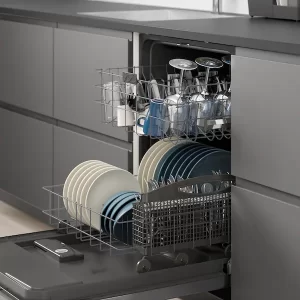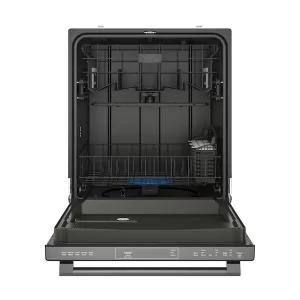When it comes to modern kitchen appliances, the dishwasher stands as a true time-saver and convenience enhancer so we need to know how to replace heating element in dishwasher. One of the unsung heroes behind its efficient operation is the dishwasher heating element. In this article, we’ll delve into what the heating element is, its pivotal role in the dishwashing process, and why you might find yourself needing to replace it?
Understanding the Dishwasher Heating Element

The dishwasher heating element is a crucial component responsible for maintaining the water temperature inside the dishwasher during the wash and rinse cycles. It’s typically located at the bottom of the dishwasher tub and is made of durable materials capable of withstanding high temperatures.
Role in the Dishwashing Process
The heating element serves a dual purpose in the dishwashing process:
Effective Cleaning:
To remove stubborn food residues and grease from your dishes, the water inside the dishwasher needs to be hot. The heating element heats the water to the ideal temperature, usually around 120-140°F (49-60°C), ensuring that the detergent dissolves effectively and that your dishes are thoroughly cleaned.
Sanitization:
High-temperature water not only cleans your dishes but also sanitizes them. It eliminates harmful bacteria and germs, leaving your dishes not only clean but also safe for you and your family to use.
Signs of a Faulty Heating Element
As time passes, the heating element can undergo gradual wear and deterioration. Here are some signs that you need to replace heating element in dishwasher:
Ineffective Cleaning:
If your dishes are coming out of the dishwasher still dirty or covered in residue, it could be a sign that the heating element is not heating the water properly.
Longer Dishwashing Cycles:
If your dishwasher’s cycles seem to take longer than usual, it may be struggling to reach the necessary water temperature due to a failing heating element.
Best Bootle Dishwasher: impressive guid
Visible Damage:
Inspect the heating element for visible damage, such as cracks or breaks. Any physical damage can affect its performance and efficiency.
Lukewarm Water:
If you notice that the water inside the dishwasher is lukewarm or cold during the wash cycle, the heating element may not be functioning correctly.
Replacing the Heating Element
Replacing a dishwasher heating element is a task that can be tackled by a moderately skilled DIYer or a professional appliance technician. Before replacing the heating element in dishwasher, be sure to:
Disconnect the power: Always disconnect the dishwasher from the power source to ensure safety during the replacement process.
Refer to the manual: Consult your dishwasher’s user manual for specific instructions and to identify the correct replacement part.
Seek professional help: If you’re unsure or uncomfortable with the process, it’s best to enlist the help of a qualified technician to avoid any accidents or further damage.
Where you can purchase replacement heating elements for dishwashers

When it comes to finding replacement heating elements for your dishwasher, there are several reliable sources online where you can purchase the right parts to keep your dishwasher running smoothly.
Many appliance parts stores, both physical and online, offer a wide range of dishwasher heating elements.
Websites like AppliancePartsPros, RepairClinic, and Amazon are great places to start your search.
When seeking replacement heating elements for dishwashers, understanding compatibility information is paramount to ensure a successful replacement process.
These heating elements come in various shapes, sizes, and configurations to fit different dishwasher models and brands. It is essential to cross-reference your dishwasher’s make and model with the replacement parts’ compatibility information provided by the manufacturer or retailer.
This ensures that the heating element you choose aligns precisely with your appliance’s specifications, preventing any installation issues and ensuring optimal performance.
Taking the time to verify compatibility guarantees that your dishwasher continues to operate efficiently, delivering the sparkling clean results you expect.
Step-by-step instructions on how to replace the heating element in a dishwasher:
Safety First: Ensure the dishwasher is disconnected from the power source to avoid any accidents.
Access the Element:
Remove the lower access panel at the base of the dishwasher to access the heating element.
Disconnect Wires:
Carefully disconnect the wires connected to the heating element. Take a picture or label the wires to remember their positions to replace heating element in dishwasher.
Remove Mounting:
Depending on the dishwasher model, you may need to remove screws or brackets holding the element in place.
Take Out the Old Element:
Gently pull out the old heating element from its housing.
Install the New Element:
Slide the new heating element into the same position as the old one, making sure it fits securely to replace heating element in dishwasher.
Reattach Mounting:
If necessary, reattach any screws or brackets that were removed earlier.
Connect Wires:
Reconnect the wires to the new heating element, ensuring they are in the same positions as before.
Test Run:
Before reassembling the access panel, plug in the dishwasher and run a test cycle to confirm that the new heating element is functioning correctly.
Reassemble:
If the test is successful, turn off the dishwasher, unplug it, and reattach the lower access panel.
General tips and resources on dishwasher repair
These are some general tips and resources for dishwasher repair and maintenance, including troubleshooting common heating element issues:
Dishwasher Maintenance Tips:
Regular Cleaning: Clean the dishwasher’s interior, including the filter, spray arms, and door gasket, to prevent clogs and odors.
Remove Food Debris: Remove any excess food from dishes prior to placing them in the dishwasher.
Use the Right Detergent: Use dishwasher detergent specifically designed for automatic dishwashers.
Run Hot Water First: Before replacing the heating element in a dishwasher, start a cycle, run the kitchen faucet with hot water to ensure the dishwasher fills with hot water right away.
Check Water Temperature: Verify that the water temperature entering the dishwasher is at least 120°F (49°C) for effective cleaning.
Troubleshooting Heating Element Issues:
Inadequate Heating: If dishes aren’t drying properly, or if you notice that the heating element isn’t hot during the cycle, it may be a sign of a faulty heating element.
Inspect Wiring: Examine the heating element’s wires and connectors for damage or corrosion. Replace any damaged components.
Test for Continuity: Use a multimeter to test the heating element’s continuity. If there’s no continuity, you will need to replace heating element in dishwasher.
Check for Sediment Buildup: Sediment or mineral buildup on the heating element can reduce its effectiveness. Clean it using a dishwasher-safe descaler.
When can I DIY Appliance Repair myself?
You can confidently embark on a DIY appliance repair project when you encounter minor issues that are well within your comfort zone and expertise.
These might include tasks like replacing a dishwasher heating element, fixing a leaky refrigerator hose, or replacing a dryer belt. With the help of user manuals, online tutorials, and basic tools, you can successfully tackle these smaller repairs. However, it’s crucial to exercise caution and know your limitations.
For complex or potentially hazardous problems, such as gas appliance issues, electrical problems, or major component replacements, it’s often safer and wiser to seek professional assistance. DIY appliance repair can save you money and empower you with valuable skills, but safety and knowing when to call in a professional should always be a priority.
How to Replace Heating Element in Dishwasher “YouTube Tutorials”
Here are some videos to help you learn How to replace heating element in dishwasher:
- How to replace the heating element in various dishwasher models
- Whirlpool Dishwasher Heating Element Replacement
- Bosch Dishwasher Heating Element Replacement
Dishwasher Manuals “Replace Heating Element in Dishwasher”
The most trusted source of information about Dishwasher Manuals is the official websites of dishwasher brands like:
Safety precautions
It’s a Safety precautions to take when working with dishwashers like replace heating element in dishwasher
When working with dishwashers, especially components like heating elements, it’s crucial to prioritize safety. Below are essential safety measures to adhere to:
Disconnect Power:
Always unplug the dishwasher or turn off the circuit breaker before replace heating element in dishwasher or beginning any repair or maintenance work to prevent electrical shocks.
Use Personal Protective Equipment (PPE):
Wear appropriate safety gear, including gloves and safety glasses, to protect against injuries and chemical exposure.
Gas Appliances:
If your dishwasher has a gas component, like a gas-powered water heater, follow specific safety guidelines for gas appliances and consider professional help for repairs.
Secure the Dishwasher:
Ensure the dishwasher is stable and won’t tip over while you work on it.
Follow Manuals:
Refer to the dishwasher’s user manual for model-specific instructions and safety information during replace heating element in dishwasher.
Avoid Wet Floors:
Keep the area around the dishwasher dry to prevent slipping hazards and electrical dangers.
Ventilation:
If you’re using any chemicals or cleaners during maintenance, ensure good ventilation to avoid inhaling fumes.
Turn off the Water Supply:
If necessary, shut off the water supply to prevent leaks during to replace heating element in dishwasher.
Double-Check Gas and Electrical Connections:
When reconnecting wires or gas lines, ensure they are properly secured to avoid leaks or electrical issues.
Test Safely:
After completing repairs, test the dishwasher in a safe and controlled manner to confirm it’s functioning correctly.

